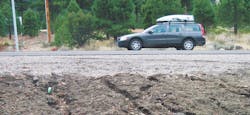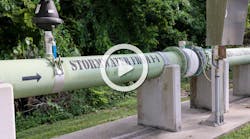About the author:
Jonas Sipaila is certified environmental manager for Evaporative Control Systems Inc. Sipaila can be reached at [email protected] or 775.813.3272.
Road construction is entrusted with four areas of responsibility to prevent road structure degradation: public safety, erosion control, water quality and water management. The persistent obstacle for safety was the presumed necessary evil of the roadside ditch. While most roads are equipped with ditches, unreliable melt water transfer to the ditches can lead to black ice in the winter months. Consequently, the physical depression of the ditch itself compromises safety.
Erosion Control Damages
Storm water management was an integral component to ditches because it was assumed it was the only way to move water from the impervious surface to a safe location. Yet the process of kinetic energy of water movement is the erosive force that not only creates, but also trans-locates the contaminants to the environment. Small rain events often are dismissed, but they establish the erosive pathways that grow bigger during larger or persistent rain events. This results in road structure damage, an obvious potential risk to user safety and ongoing rebuilding costs.
For transportation agencies, the biggest headache of road construction is the persistent maintenance activities of cleaning road side ditches, shoulder repair, pot hole repair and resurfacing. Spending on state-owned roads totaled $132 billion in 2012. In addition, annual ditch cleaning is estimated at $1,500 per mile by the U.S. Department of Agriculture, and there are more than 4 million miles of roads in the U.S.
In almost all instances of road repair, the initiating culprits are storm water and the infrastructure system. Surface movement causes the erosive forces that erode soft shoulders and add deposits to culverts and ditches. Road cracks and unpredictable subsurface water movement soften road edges, and subsequent freeze thaw cycles undermine the integrity of the road foundation and initiate soft spots that then create pot holes.
Water Quality & Management Concerns
In many regions, there is a water quality epidemic of nutrient contamination in water bodies. Contamination sources from roadways include chemical spills and other, less-obvious sources, such as sediment deposits, tire wear, break disc wear and vehicle fluid leaks. For example, an average car will leave behind 3.4 lb of rubber per 50,000 miles of tire travel. Tire rubber consists of 30% carbon black, which is composed of an array of both organic and inorganic chemicals. Heavy metals, such as cadmium, lead and chromium, are a relatively small percentage of less than 60 ppm, yet calcium, iron, magnesium, phosphorus, potassium and zinc are molecules present at a much higher percentage and have fertilizer value, which are added to bodies of water.
Crude road filtration practices have been attempted throughout recent decades with less than desirable or measurable improvement. Most were adaptations to the established infrastructure of catch basin, curb and gutter designs. Cultural attempts of informational and expensive castings of catch basins made an obvious awareness. However, the same individual has no power to control the pollutant event during storms or stop the volume of contaminated storm water.
Possible Solutions
Some solutions to managing roadway runoff are more effective than others. Geo-fabric inserts, for example, often are overwhelmed, can plug or rip, and have no effect on phosphate laden clay particles, dissolved solids or oil sheens. The effectiveness of sand filtration, however, has been unchallenged in water filtration practices. Although, using common perforated pipe on a large scale to filter storm water provided mixed results and complications.
Austin, Texas, was a pioneer in the early 1990s using sand filter ponds and basins for treating destination point storm water. Although the initial trials demonstrated a high total dissolved solids (TSS) removal efficiency, there were best management practice (BMP) problems, including requiring more maintenance; requiring more hydraulic head to operate properly; high solid loads caused the filter to clog; and filters in residential areas presented aesthetic and safety problems.
In the early 2000s, development of a non-clogging sub-surface drainage pipe that can work in a quicksand environment resolved the problems of cost and maintenance and initiated a new avenue for storm water management. The Environmentally Passive Integrated Conveyance (EPIC) system combined simple physics of a gravity trap and bi-directional movement of water. The underground systems filtered and reused captured storm water for final passive pollutant treatment.
Successful Applications
The early pioneers of the new technology came from California and Nevada with a need to solve a specialized problem and to open up other beneficial adaptations of the technology. A California estate restructured their courtyard area to capture all rain events through the gapped pavers over the EPIC system to filter surface events and channel the captured water to a 30,000-gal cistern. While easily maintaining infiltration rates of more than 4-in. rain events through the sand base without puddling, the water quality is exemplified by the storm water directly reused in the fountain feature.
A Modesto, Calif., veterinary hospital used a 2-ft-wide porous paver collection strip. The gravel-filled strip of EPIC chambers collects and filters all rain events to be stored in a 300,000-gal underground reservoir situated just below the paved access road. The captured and filtered water is then reused, not only for all their landscaping needs, but also as a heat exchanger to cool the main building.
In 2015, at a vehicle maintenance facility in Carson City, Nev., the Nevada Department of Transportation (NDOT) installed a 4-ft-wide porous EPIC perimeter filter to collect and filter all storm water from a 10-acre site. The filter not only retains all particles greater than 1 mm at the surface, which are easily serviced by a sweeper, but also passively and biologically treats oil residues within the profile to prevent hydrocarbon discharges to the subsequent storm water conduits.
In 2016, a new 1,500-ft access roadway serving more than 100 paved parking spaces was constructed at Incline Village, Nev. The Lake Tahoe Regional Planning Agency has stringent regulations to protect Lake Tahoe’s clarity. Part of the East Shore Tahoe Trail project’s goal is to efficiently make use of the real estate near Lake Tahoe’s shores, while also protecting the environment. The project functions to passively collect and filter the runoff and snow bank melt before it transfers to the lake. The project has no catch basins and the water is managed by gravity in five stages, including:
- Immediate surface filtration at the course sand interface between the pavers;
- Surface adhesion of organics on fine gravel surfaces;
- 3-in.-deep water detention benches stepped below the pavers to initiate ground water absorption;
- Solar heating and aerobic decomposition of organic contaminants between storm events; and
- Automatic excess water transfer of clean filtered water to the Lake Tahoe watershed.
The concept of passive road filtration is a simple solution to a complex and widespread problem. Sediments are intercepted and captured to be removed by surface maintenance. Contaminants and hydrocarbons are broken down by microbial degradation that takes place subsurface in the new BMP profile. Nutrients also can be absorbed by adjoining BMPs with landscape plants through biological remediation. Real estate is maximized by eliminating storm ponds and transferring the function to drivable structures.


